by Vincenzo Russo
Labels and packaging play a crucial role in a consumer’s initial choice of wine. For less experienced buyers, when prices are equal, the label is a key factor in purchasing the first bottle. But are there ‘correct’ labels and less effective ones?
Eye movement analysis
Given the diversity of wines sold in both the Italian and international markets, we analysed the labelling of a selection of wine brands and their packaging to assess their attractiveness. The goal of the research was to determine which areas of the label generated the most interest or engagement, using an eye tracker to measure eye movement on the shelf and across the labels. These labels fell into two broad categories: those with vertically oriented designs and graphic features, and those with similar elements arranged horizontally.

Consumers prefer vertical labels
The most significant finding is that, due to the Z-pattern of human reading (left to right and top to bottom), consumers generally view labels from top to bottom. Elements that are far from the central vertical line tend to receive less attention, with exceptions for particularly attractive or captivating designs, such as a well-known brand or a famous iconographic image. As a result, consumers typically view labels vertically, with elements away from the central vertical line receiving less focus.
Abstract designs don’t help
On the other hand, labels with conceptual or abstract designs require more effort from the consumer to decipher, which can detract from the attention given to other elements. This conclusion is logical since, in advertising, it’s crucial to overcome perceptual barriers and ensure that the message is absorbed and retained by the recipient. Additionally, it’s important to remember that for the primitive brain, driven by emotions and instinctive processes, the principle of “less is more” holds true, especially in a cultural context where simplicity, sobriety, and naturalness are the most persistent trends amidst a backdrop of multiple crises.


 Meloni: "Tariffs? If necessary, there will be consequences. Heavy impact on agri-food sector"
Meloni: "Tariffs? If necessary, there will be consequences. Heavy impact on agri-food sector" The Government honours the greats of Italian cuisine, from Bottura to Pepe. Massari: "Thank you, Meloni, the only one who listened to us"
The Government honours the greats of Italian cuisine, from Bottura to Pepe. Massari: "Thank you, Meloni, the only one who listened to us" "We must promote a cuisine that is not just for the few." Interview with Massimo Bottura
"We must promote a cuisine that is not just for the few." Interview with Massimo Bottura Wine was a drink of the people as early as the Early Bronze Age. A study disproves the ancient elitism of Bacchus’ nectar
Wine was a drink of the people as early as the Early Bronze Age. A study disproves the ancient elitism of Bacchus’ nectar "From 2nd April, US tariffs between 10% and 25% on wine as well." The announcement from the Wine Trade Alliance
"From 2nd April, US tariffs between 10% and 25% on wine as well." The announcement from the Wine Trade Alliance






